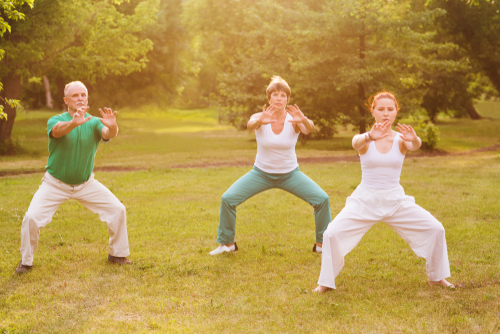
Tai Chi has many health benefits for mind and body. As part of a healthy lifestyle it is an accessible, safe and effective exercise with positive effects for physical health and mental wellbeing. It can take a while to become familiar with the rhythm and feel of tai chi, perhaps three to six months, However, once they are over the initial learning phase, most people continue with the exercise.
On top of everything else, with Tai Chi and Qi Gong there’s the bonus of having a sound wellbeing, healthier soft tissue and joints, more body strength, better mobility and posture, increased blood flow and immunity, less tension and more inner peace.
What is Tai Chi?
Tai Chi is essentially a mind body exercise. It originated as a martial art and is rooted in Chinese philosophy. You don’t need to subscribe to the underlying beliefs to enjoy the health benefits. On the other hand, understanding the concepts can make sense of the approach. For example, Qi is an energy force which flows through the body. Tai Chi helps unblock and encourage the proper flow of Qi. Additionally, Yin and Yang are opposing and complimentary elements. Together, they create balance and harmony. Tai Chi promotes this balance.
The language can be confusing. However it need not be intimidating. The styles of Tai Chi are given names like Sun, Yang, Wu and Chen. This is in honour of the masters who devised the forms. The names of the movements are drawn from nature. They sometimes sound a bit obscure, but they are creative and add a sense of expression to the practice.
Physical health benefits of Tai Chi
Tai chi is slow and gentle and doesn’t leave you breathless. However, it still addresses the key components of fitness.
Muscle strength. Tai chi can improve both lower-body strength and upper-body strength. When practiced regularly, it can be comparable to resistance training and brisk walking. Although you aren’t working with weights or resistance bands, the unsupported arm exercise involved in tai chi strengthens your upper body. The slow stepping and weight transfer, combined with a lowered stance, helps to strengthen the lower body. In addition, the smooth controlled movement with focussed body awareness promotes strength in the core muscles of the back and abdomen.
Flexibility. Tai chi can boost upper- and lower-body flexibility as well as strength.
Balance. Tai chi improves balance and, according to research, reduces falls. Proprioception — the ability to sense the position of one’s body in space — declines with age. Tai chi helps train this sense, which is a function of sensory neurons in the inner ear and stretch receptors in the muscles and ligaments. Because Tai chi improves muscle strength and flexibility, it makes recovering from a stumble easier.
Practiced regularly, Tai Chi can help reduce pain. For instance, the pain associated with knee osteoarthritis, back problems, and fibromyalgia. In addition, it can significantly lower the risk of falls among older adults.
It’s good for the mind too
Mind body exercises actually have the same physical effects as aerobic exercise. Mind body exercises can help with sleep disturbances and mood disorders. Fear of falling can make you more likely to fall. Studies have found that tai chi training helps reduce that fear.
At Movement In Mind, we believe tai chi for is for everyone. It improves health and quality of life by exercising our minds as well as bodies. In addition, it empowers us to be more healthy and harmonious with ourselves, with others, and with the world.
Our wellbeing programme includes online and in person Tai Chi sessions. We aim to make tai chi accessible, inclusive and enjoyable. Many people with chronic conditions, such as Diabetes, who would not have thought of trying tai chi discover they like the exercise and health benefits. So much so, that it becomes a lifelong activity as they continue to enjoy and grow in their tai chi practice.

3 thoughts on “Health Benefits of Tai Chi”
Comments are closed.